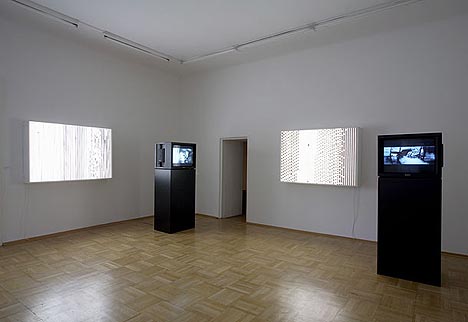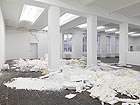
translated and summarized by: Liz Wollner-Grandville,
English summary February 11 - 17
Galerie nächst St. Stephan - Peter Tscherkassky - From a Dark Room
Working on the motion picture
Peter Tscherkassky`s film work seems to transform the work of his critics into a frenzy of language: it raves, lurks, creeps, bangs or skids in every text. As if the experimental filmer and Master of Philosophy is trying to prevent any additional verbal tests of this sort, he displays some of his worldwide renowned and prize-winning film works in a gallery in such a way that the focus is on the process of how it developed: terminals show film excerpts on DVD. In the light boxes placed next to these terminals the physical film material is displayed, which corresponds to the respective film excerpt shown. The visual analysis of these motion pictures brings about a two-fold disillusionment: lacking their optimal presentation-environment, frame by frame a striptease is performed.
Every discipline has its own myths, its own special ambience. The ambience of a movie is the dark movie theatre, which Tscherkassky only rarely does without. In opposition to the continuous advance of generating digital film he focuses on the physique of the medium. Found footage serves as the source material - such as Sergio Leone's classical Italo Western "The Good, the Bad and the Ugly". In his exhibit he clearly shows how he uses it frame by frame. The instruments of his work are presented in a glass showcase - and you will not find a camera or any other optical apparatus. Numerous light boxes show how the material was fashioned by hand or with a laser pointer: such as clippings from Tscherkassky`s films "L`Arrivée (1997/98), "Outer Space" (1999), "Dream Work" (2001) and "Instructions for a Light and Sound Machine" (2005). Two works under the title "motion picture" were combined as installations.
"Motion Picture", his oldest work, clearly shows the main idea behind his oeuvre: here you will see a single frame from the first film ever produced, Louis Lumières "La sortie des usines Lumières", made in 1895, copied onto a rectangle of frames arranged next to one another. The abstract film, which developed out of the fragmentation of one picture into numerous consecutively played pictures, is shown here. In contrast,
Tscherkassky`s later movies are extremely sensuous; even if, or maybe because of, the manually or consciously unequal light effects, sometimes distorted frames, deferred sound tracks, and inserted objects such as thumbtacks or the filmmaker`s hand. The reference to Man Ray and photography is obvious. Tscherkassky follows the historical Avantgarde concept and through the twofold acquirement - methods and material - he creates something new - an exciting ambiguity.
Galerie nächst St. Stephan
1010 Vienna, Grünangergasse 1 / 2, until 23.02.08
www.schwarzwaelder.at
ZKM - Zentrum für Kunst und Medientechnologie: Candida Höfer, Work groups since 1968
Sample rooms for room samples
Over the past decades Candida Höfer`s view of the world has become increasingly dissociated. While in 1968 she captured street scenes, snapshots of a lively but anonymous urbanity, her works created one decade later depict "Turks in Germany" and deal with the everyday life of migrant workers. In family surroundings, in tea rooms, in the park or on the street, the artist objectively and without any prejudice observes how people meet. Especially those people whose home country is elsewhere.
Numerous waiting rooms, those more or less welcoming venues, which have a lot to do with stopping between two different locations, marked another step of her oeuvre, which is involved with the unlimited variations of limited space. The public and half-public places were not specially staged, the encountered light situation was not adapted, the camera stayed on eye-level, only a wide-angle lens provides for the desired conception of the room.
Libraries are among the favourite motives of the extremely reserved artist. She removed herself from people and situations, concentrates on venues and rooms, to position the linear clarity of a room structure, and with this clarity the formats of the photography increased.
The change in Candida Höfer`s work over the last four decades with respect to the way it is presented and the thereby arising new requirements for exhibition space is informative. It ranges from small works grouped in a series to large-scale photography, and the "Prosessions", in which photographs can only be viewed on a desktop terminal with no further explanation offered.
"Exhibition design and curatorial practice" was at first only meant to be a practical assignment for the working group of the University for Design in Karlsruhe (Hochschule für Gestaltung). It has turned into an interesting overview of the work - selected by the ZKM in collaboration with Candida Höfer: small-scale, classy, and partly unpretentiously displayed.
ZKM - Zentrum für Kunst und Medientechnologie,
Karlsruhe, Lorenzstrasse 19, until 02.04.08
www.zkm.de
KW Institute for Contemporary Art: ... 5 minutes later
Good Timing
Sometimes one would hope that writing a review like this one would only take five minutes. After all, that is about the amount of time, revered reader, you will need to read it. But typing the words alone will not do the trick. First there are a few weighty ideas, an unerring judgement and an explanation that must be put into words - all that can take quite a while. But then there is this glaring injustice which not only affects the reviewer, but even more so the artist: the persistent "art hype", an outcome of the vast number of exhibits, biennales and fairs, pushes him/her into the dilemma of having to satisfy the audience`s greed. The result being that some of the works really look like they were made in only five minutes...
Therefore this experimental show came at exactly the right time. After a year, which was characterized by the annus mirabilis of mega art events, however, without any mega outcome. Susanne Pfeffer, curator and just recently appointed as the new head of the Kunstwerke, has taken on the role of a martinet: for this exhibit the artists were forced to complete a work of art in only five minutes. This turned out to be a real "curator`s coup", which succeeded in making the contrast between disegno (sketch) and pittura (the completed work of art) visible.
But amazingly enough the 15 artists do not feel limited by this theoretical ballast (except for Robert Barry, who, not surprising, explicitly refers to the limitation). The pressure, which is normally created by such things as expectation and perfection seem to be non-existent, allowing the release of playful energy.
KW Institut for Contemporary Art
10117 Berlin, Auguststrasse 69, until 09.03.08
www.kw-berlin.de
Galerie Andreas Huber: Carola Dertnig - Anna-Lülja Praun`s Legacy
Perceptive Interaction
Constraint, variation, and the readiness to take risks -these three components characterize the very personal appreciation of architect and designer Anna Lütja Praun`s work, currently shown at the Gallery Andreas Huber.
A soundtrack, shaped and narrated by Carola Dertnig, the artist and creator of this exhibit, presents numerous chapters of Praun`s life. The narration is supported by slides showing the architect's apartment.
Small-scale architectural projects, as well as interior and furniture design form the main focus of Praun`s oeuvre. Her work is strongly characterized by her self-imposed maxim: "the validity of the form must be as durable as its material".
Dertnig, whose artistic development was strongly influenced by Praun, constructs an interaction with multitudinous objects, by jumping from a subjective perception, the narration of public existence, and insights into Praun`s private life.
Timeless interior design as well as objects formed by Anna-Lülja Praun`s long and sophisticated life experience, are the secret to her success.
The "exhibited" time of Praun`s being offered her both space and content; and this is excellently implemented in Dertnig`s display. One`s own perception of certain standpoints can be enhanced by a voyage undertaken in Praun`s spirit.
Galerie Andreas Huber
1060 Wien, Capistrangasse 3, until 08.03.08
www.galerieandreashuber.at
Mehr Texte von translated and summarized by: Liz Wollner-Grandville


 Teilen
Teilen




